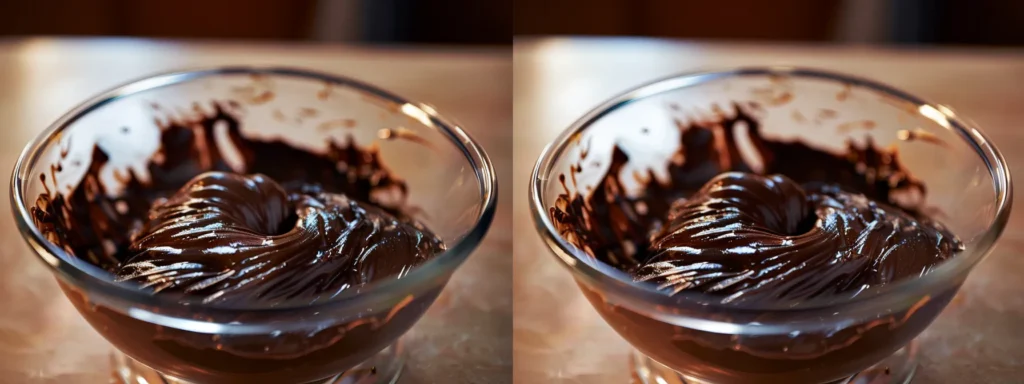Last Updated on October 2, 2024 by Timothy Byron Smith
Mastering Chocolate Cake Mixing: Key Techniques for Optimal Results
Are you struggling to achieve the perfect chocolate cake? Mixing your batter properly can make all the difference between a dry cake and a moist, flavorful treat. In this blog post, you’ll learn essential techniques for mixing chocolate cake batter, including key ingredient selections and proper mixing tools. By addressing common mixing errors and providing advanced strategies, you’ll be equipped to create a delicious chocolate cake that could easily rival a wedding cake. Let’s tackle the challenges of mixing, so you can enjoy a rich, satisfying dessert every time.
Understanding the Fundamentals of Chocolate Cake Mixing
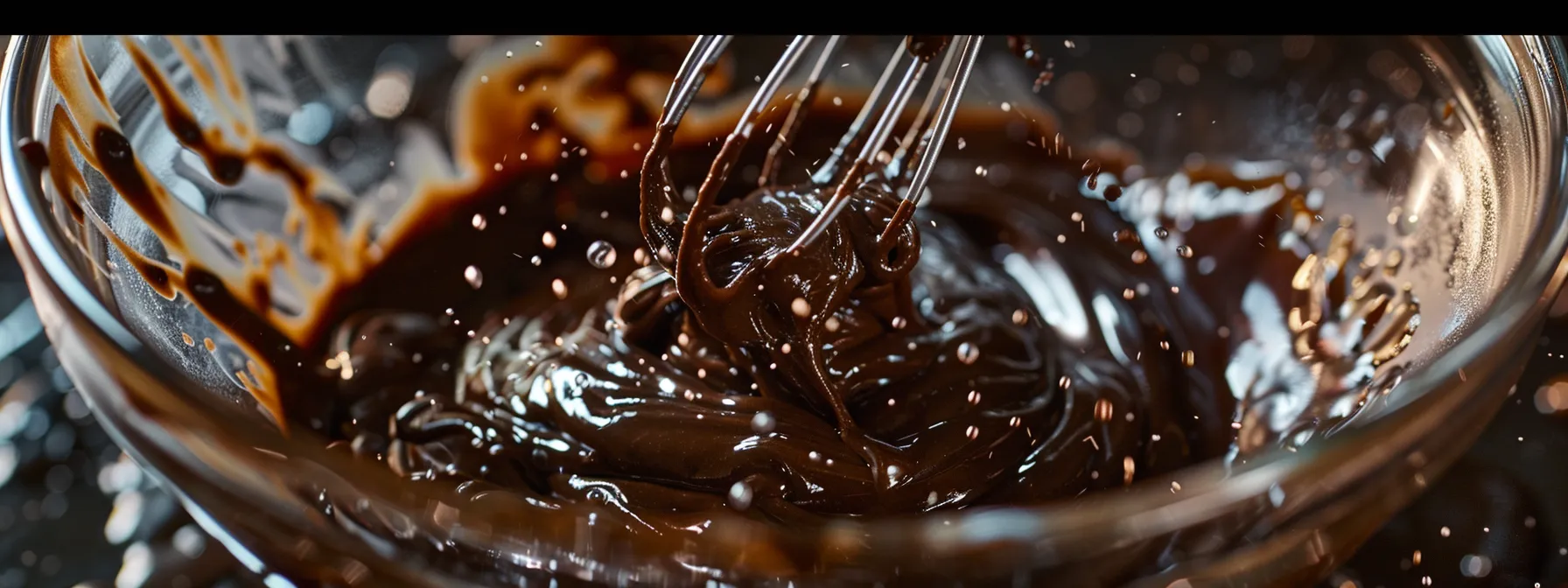
The way you mix your chocolate cake batter can significantly influence the cake’s texture. Understanding various mixing techniques will help you create a light, airy sponge or a rich, dense bundt cake, depending on your desired outcome. Additionally, the sequence of ingredient incorporation is essential for achieving the perfect balance, whether you’re making a mousse-like frosting or a classic buttercream. Each of these aspects plays a crucial role in baking a delightful chocolate cake.
The Influence of Mixing on Cake Texture
The way you mix your chocolate cake batter directly affects the final texture of the cake. For example, if you want a light sponge similar to a pound cake, you should incorporate air into the batter by mixing the ingredients gradually, ensuring a good volume. Additionally, using vinegar in your batter can enhance the leavening process, resulting in a lighter cake, while careful mixing of powdered sugar in your frosting will yield a smooth, creamy finish that complements the rich chocolate flavor, ensuring your baked goods have the perfect pastry-like quality.
Exploring Various Mixing Techniques
Mixing techniques play a pivotal role in achieving the desired texture and flavor of your chocolate cake. For optimal results, consider the creaming method, where you beat softened butter and sugar together until fluffy, incorporating air into your batter for a light cake. Alternatively, if you opt for a denser cake, such as one that incorporates oatmeal or has fondant icing as a decoration, you can use the all-in-one method, which allows you to combine all your dry ingredients, like flour and cocoa powder, with your wet ingredients in a single step, leading to a rich and hearty dessert.
Sequence of Ingredient Incorporation
The sequence in which you incorporate ingredients when mixing chocolate cake batter significantly affects the texture and overall outcome. Begin by creaming together the butter and sugar using a spatula or a wire whisk, which allows air to enter and helps the cake rise. For variations in altitude, where air pressure affects baking, consider adjusting the amount of moisture or using parchment paper for lining your baking pan, ensuring a smooth release and perfect finish for your cake. Incorporating ingredients like peanut butter at the right stage can also enhance flavor while maintaining a desirable texture, so pay attention to each step for optimal results.
Selecting Essential Ingredients for Optimal Mixing Results
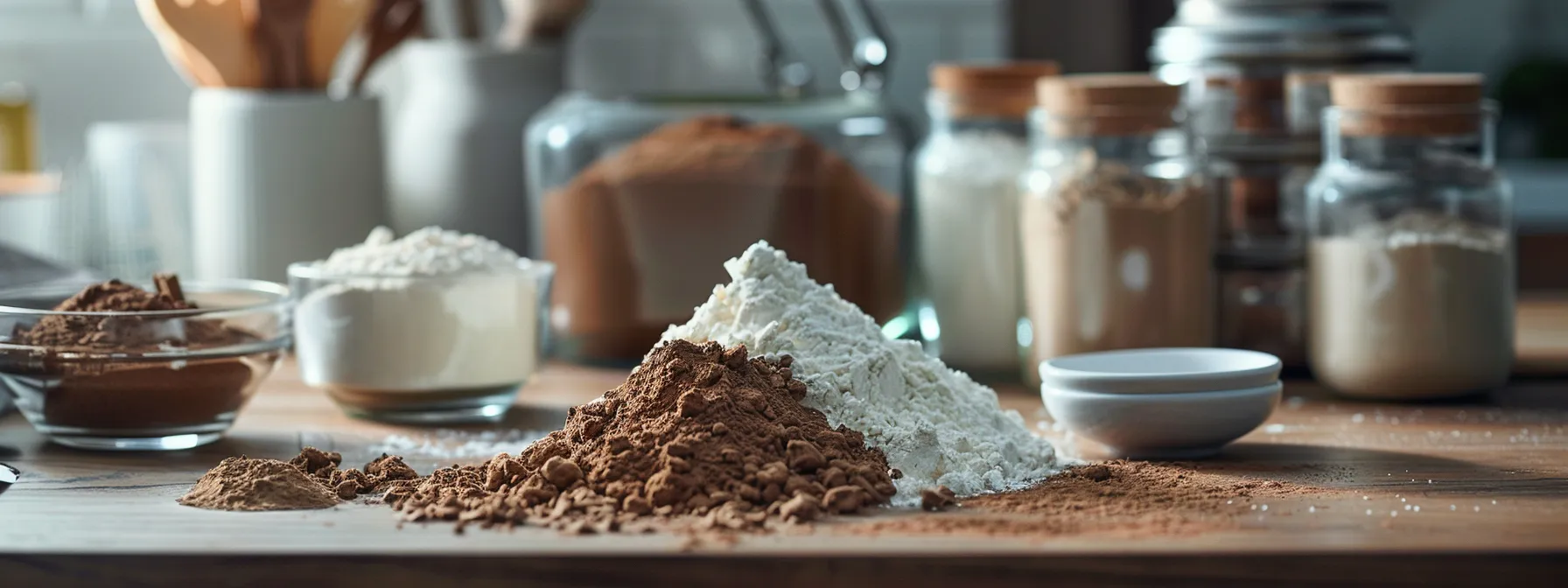
Choosing the right flour type is essential for achieving the desired chocolate cake texture. High-quality cocoa powder enhances flavor while different sugars can affect sweetness and moisture. Understanding the role of leavening agents, along with properly balancing liquids and fats, including peanut butter, is crucial. This section will cover these elements in detail, equipping you with practical insights for successful mixing.
Choosing the Appropriate Flour Type
Choosing the appropriate flour type is vital for achieving the best taste in your chocolate cake. For a rich and dense cake, consider using cake flour, which has a lower protein content and creates a tender crumb. If you’re experimenting with flavors, such as incorporating raspberry or stout into your batter, a versatile all-purpose flour can provide the structure needed to support these unique tastes while keeping the cake moist. Additionally, when preparing your cake in a springform pan, the right flour can help ensure a clean release and a professional presentation.
Importance of High-Quality Cocoa Powder
Selecting high-quality cocoa powder can transform your chocolate cake into a truly exceptional dessert. The richness and depth of flavor depend significantly on the cocoa powder you choose, as it directly impacts the overall taste profile of your cake. When you combine the cocoa powder with other ingredients in your mixing bowl, remember that using a spoon to gently fold in melted coconut oil can enhance the moisture and promote a lighter texture, resulting in a cake that pairs beautifully with custard for a decadent finish.
Effects of Different Sugars on Mixing
The type of sugar you choose can significantly impact the outcome of your chocolate cake, affecting both flavoring and texture. For a silky fudge-like consistency, consider using brown sugar, which not only adds moisture but also enhances the cake’s depth of flavor with its richer undertones. On the other hand, granulated white sugar offers a cleaner sweetness that helps create a light, airy texture when mixed with wheat flour, ensuring proper aeration in your batter. Additionally, if you add a pinch of sodium, it can help balance the sweetness and amplify the overall taste of your cake, while a touch of cream in the recipe can further enrich the mouthfeel, creating a truly delectable dessert.
Role of Leavening Agents in Batter Mixing
Leavening agents play a crucial role in the mixing process of your chocolate cake batter, influencing the final rise and texture. Whether you’re using baking powder or baking soda, these agents help create air pockets within the batter that lead to a light, fluffy cake. If you’re working with Dutch process cocoa, be mindful that it often requires an acid to activate the leavening agents, so consider incorporating ingredients like buttermilk or vinegar. Additionally, ensuring that your ingredients, especially butter and eggs, are at room temperature allows for more effective mixing and better leavening, promoting even texture throughout the cake. To elevate your creation, don’t forget about finishing touches like a white chocolate glaze and colorful sprinkles for an appealing presentation.
Balancing Liquids and Fats Correctly
Balancing liquids and fats correctly is essential in achieving the ideal consistency for your chocolate cake batter. Incorporating ingredients like buttermilk and heavy whipping cream adds moisture while maintaining a rich texture. For an enhanced flavor profile and added structure, consider including a yolk from the eggs and some starch from ingredients like pudding mix, as this combination can result in a tender and moist cake that stands out for its quality.
Utilizing Proper Mixing Tools and Equipment
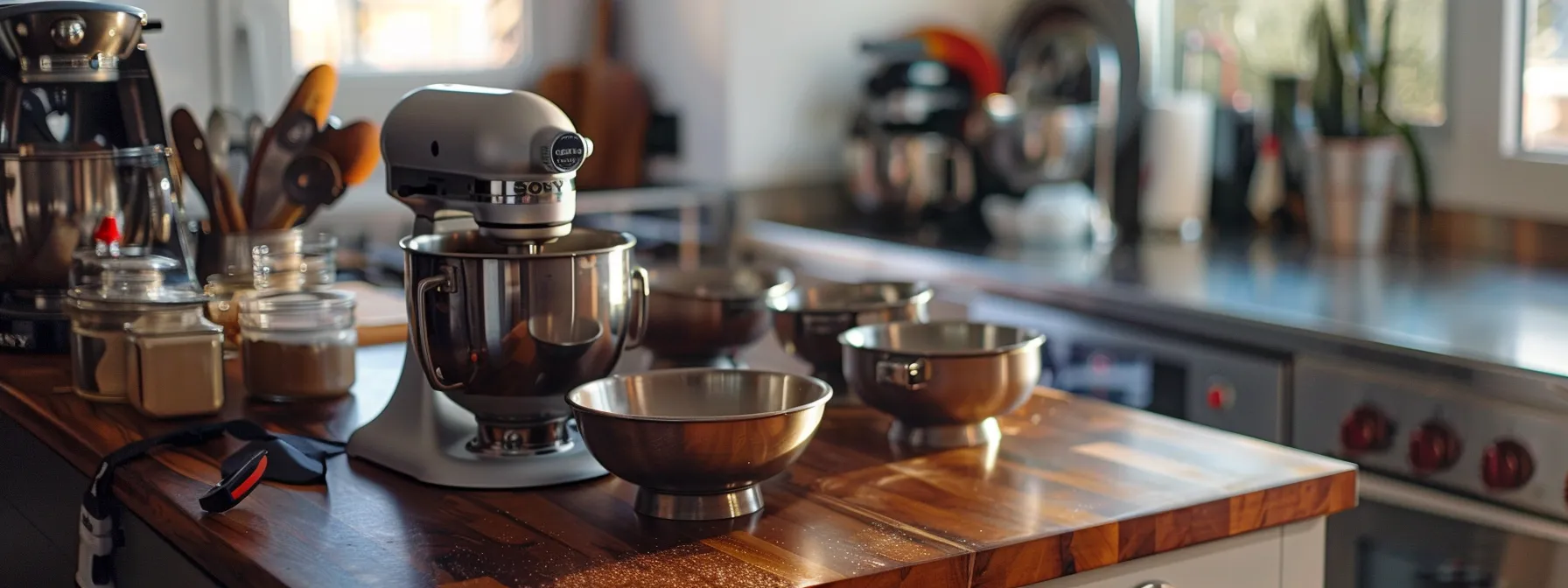
Utilizing the right mixing tools and equipment is crucial for achieving optimal results in chocolate cake preparation. Different mixing bowls can enhance your performance, while selecting effective utensils ensures thorough mixing. You’ll also weigh the advantages of electric mixers against manual methods. Lastly, maintaining your mixing equipment, including proper care for surfaces that might touch ingredients like vegetable oil and almond, will keep your tools in top condition. Each of these aspects supports successful mixing and contributes to your cake’s overall quality.
Advantages of Different Mixing Bowls
Selecting the right mixing bowl can greatly impact your chocolate cake‘s quality, especially when considering various batter types, such as a rich sheet cake or a gluten-free option. For instance, using a stainless steel bowl allows for better insulation, which helps maintain a consistent temperature for ingredients like coconut milk and vanilla extract, promoting even mixing. Furthermore, a large mixing bowl provides ample space for whisking, ensuring you achieve the desired airy texture essential for a light, fluffy cake.
Selecting Effective Mixing Utensils
Selecting effective mixing utensils is critical for any baker aiming to achieve a flawless chocolate cake. For example, a sturdy whisk is ideal for blending egg whites into your batter, ensuring they incorporate air for a light texture, while a spatula is perfect for folding in melted dark chocolate without losing volume. Additionally, using quality measuring cups can help you precisely incorporate extracts like vanilla or almond, which enhance your cake’s flavor profile, whether you’re working on a classic chocolate cake or a festive red velvet cake.
Comparing Electric Mixers and Manual Methods
When deciding between electric mixers and manual methods for mixing chocolate cake batter, each approach has its merits. Electric mixers, for instance, can quickly whip butter and sugar into a creamy buttercream or blend in chocolate chip cookie dough with precision, saving you time and effort, especially when working with ingredients like cocoa powder. On the other hand, manual methods allow you to maintain more control over the mixing process, enabling you to adjust the texture and consistency by the gram, making it easier to create that perfect blend for your specific recipe needs.
Care and Maintenance of Mixing Equipment
Proper care and maintenance of your mixing equipment is essential for achieving the best results in chocolate cake mixing. Regularly clean your mixer and utensils to prevent the buildup of syrup or dairy residue, which could affect future recipes. Additionally, using a little olive oil on beaters can help maintain their effectiveness by ensuring moisture doesn’t become trapped, allowing for seamless mixing every time you bake.
Techniques for Mixing Chocolate Cake Batter Effectively
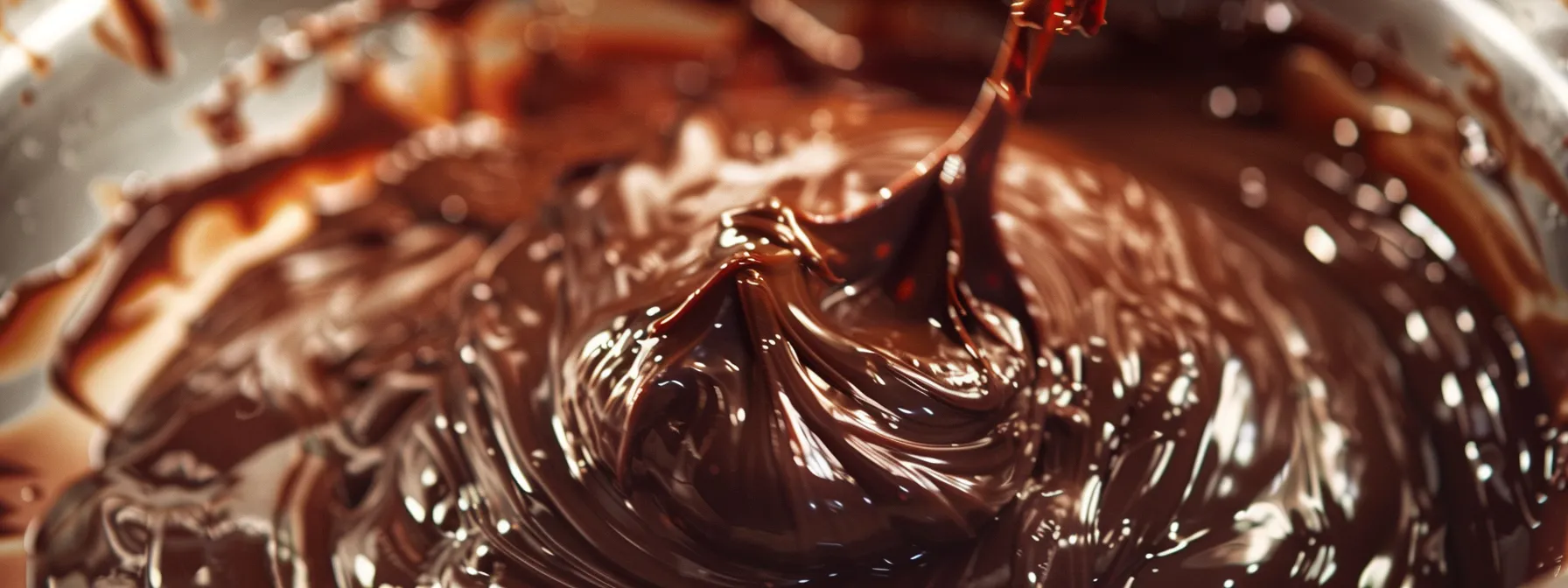
Techniques for Mixing Chocolate Cake Batter Effectively
Preparation is key to success in chocolate cake mixing. Begin by gathering your ingredients and ensuring they are at room temperature. In the following sections, you will learn how to cream butter and sugar effectively, integrate dry ingredients smoothly, blend wet ingredients uniformly, and achieve the desired batter consistency. Understanding these techniques will enhance your cake decorating efforts and optimize the ratio of flavors, creating a cake that meets your expectations.
Preparation of Ingredients Prior to Mixing
Before you begin mixing your chocolate cake batter, it’s essential to prepare your ingredients properly. Make sure that items like butter, eggs, and cream cheese are at room temperature, as this will help them blend more smoothly and evenly. Additionally, if you are using an acidic ingredient like buttermilk or vinegar, be aware that it interacts with your baking powder or soda, influencing the overall sweetness and creating a lighter texture in your final cake.
Creaming Butter and Sugar Successfully
Creaming butter and sugar successfully is a fundamental technique that sets the stage for a fluffy chocolate cake. Start by using softened butter, which allows for easier mixing and better incorporation of air. You can use a stand mixer or a hand mixer on medium speed for about 3 to 5 minutes until the mixture appears light and creamy. If you’re making a ganache as a topping, you may want to keep some olive oil handy to add richness without compromising the texture. This creaming method is beneficial when preparing cake batters for a sheet pan or learning how to create a hot chocolate-inspired cake, ensuring the dessert rises beautifully during baking.
Integrating Dry Ingredients Smoothly
Integrating dry ingredients smoothly is crucial for achieving a consistent and appealing batter in your chocolate cake. When blending flour, cocoa powder, and kosher salt, use a gentle folding motion to prevent overmixing, which can lead to a tough texture. To enhance the mouthfeel of your cake, consider adding sour cream to the batter; this will not only create a richer flavor but also contribute to a moist, chocolate brownie-like consistency that elevates your dessert. Maintaining this careful balance during integration ensures a smooth sauce-like finish to your batter, leading to delicious results every time.
Blending Wet Ingredients Uniformly
Blending wet ingredients uniformly is a critical step when mixing chocolate cake batter, as it ensures that flavors and textures are evenly distributed throughout the mixture. When incorporating ingredients like oil or crème fraîche, you should whisk them together until the mixture is smooth, helping to integrate the cocoa solids effortlessly. This uniformity not only contributes to a moist, rich cake but also enhances the overall flavor profile by allowing spices or additional flavorings to meld seamlessly, creating a delightful balance that elevates your chocolate cake to a true gourmet experience.
Achieving the Desired Batter Consistency
Achieving the desired batter consistency when making a chocolate cake is crucial for the final result. You want to aim for a smooth mixture that flows easily but holds its shape, similar to a chocolate chip cookie dough. If you find your mixture too thick, adding a splash of milk chocolate or a touch of caramel can enhance the moisture and richness, ensuring a tender crumb in your cake. Pay attention to the texture as you mix; this will greatly affect the overall quality of your baked dessert.
Preventing Common Mixing Errors
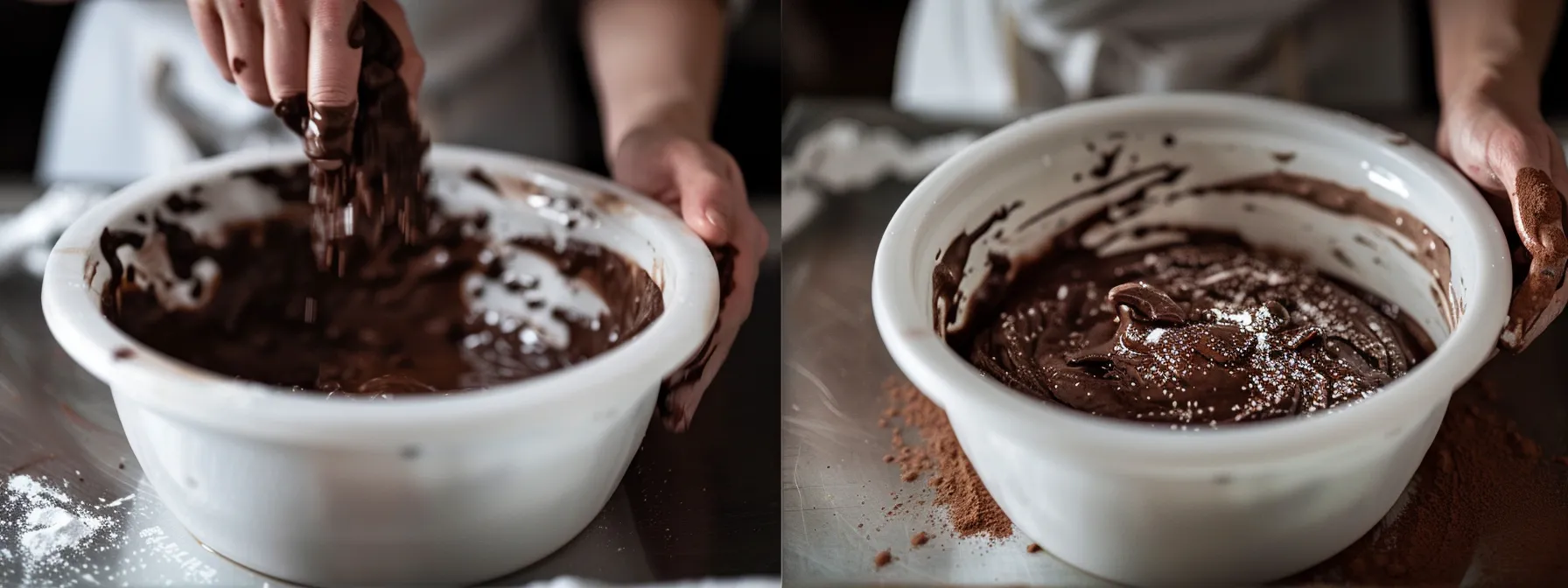
To achieve optimal results when mixing your chocolate cake, it’s essential to prevent common errors that can affect the final product. You’ll learn about identifying and avoiding overmixing, which can lead to a tough texture, and ensuring complete ingredient incorporation for a uniform cake. Additionally, managing ingredient temperatures properly will help achieve the perfect blend, while resolving issues with lumpy batter ensures a smooth consistency essential for delicious desserts.
Identifying and Avoiding Overmixing
Identifying and avoiding overmixing is crucial for achieving the perfect texture in your chocolate cake. When using a paddle attachment, mix just until the ingredients are combined; excessive mixing can lead to a dense, rubbery sponge cake. To ensure the right consistency, consider the measurements carefully, such as adding one tablespoon of brown sugar at a time, allowing for better control over the texture, as outlined in your favorite cookbook.
Ensuring Complete Ingredient Incorporation
Ensuring complete ingredient incorporation is essential for a well-mixed chocolate cake batter. To achieve this, you might find it helpful to use a toothpick to test for any dry pockets of flour or cocoa powder after mixing; if it comes out clean, your batter is ready. Pay attention to mixing techniques, like gently folding in ingredients such as shredded coconut or finely chopped chocolate bar, which can enhance both texture and flavor, resulting in a more delightful finished product that pairs perfectly with whipped cream or adds depth to a chocolate tart.
Managing Ingredient Temperatures Appropriately
Managing ingredient temperatures appropriately is essential for achieving a well-mixed chocolate cake batter. When ingredients like butter and eggs are at room temperature, they blend more easily, which helps create a consistent texture in your cake. For example, if you add cold eggs directly from the fridge, they can cause the batter to seize, leading to an uneven mix and potentially dense cake. Ensure you take a few minutes to allow these key ingredients to warm up before starting your mixing process.
Resolving Issues With Lumpy Batter
Resolving issues with lumpy batter is essential for a successful chocolate cake. If you notice lumps in your mixture, this often results from improperly sifted dry ingredients or cold ingredients not blending well. To fix this, gently fold in your dry ingredients in smaller increments and ensure your wet components are at room temperature for a smoother blend, eliminating those pesky lumps and achieving a consistent batter that promises an even bake.
Advanced Mixing Strategies for Perfect Chocolate Cake
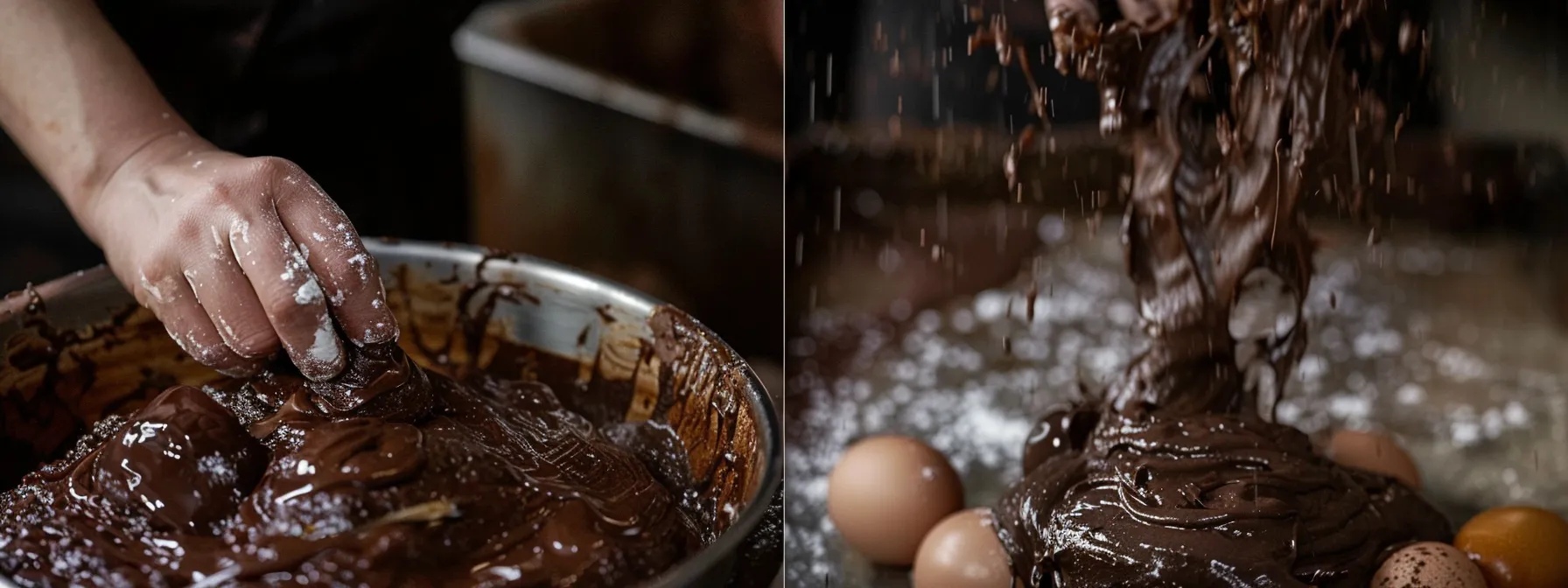
Advanced Mixing Strategies for Perfect Chocolate Cake
Implementing effective mixing strategies is crucial for achieving the perfect chocolate cake. This section explores techniques such as folding to retain air, the reverse creaming method for added texture, and incorporating whipped eggs for enhanced lightness. Additionally, adjusting your mixing techniques based on environmental factors ensures consistent results, no matter where you bake.
Implementing Folding Techniques to Retain Air
Implementing folding techniques is essential for retaining air in your chocolate cake batter, which is key to achieving a light and airy texture. When you gently fold in ingredients like whipped egg whites or dry components, you incorporate air without deflating the mixture, ensuring your cake rises beautifully. Aim to use a spatula in a smooth, sweeping motion to maintain volume; this approach allows the ingredients to blend seamlessly while preserving the delicate structure necessary for a superior chocolate cake.
Applying the Reverse Creaming Method
Applying the reverse creaming method can significantly enhance the texture of your chocolate cake. By starting with your dry ingredients, such as flour and cocoa powder, and mixing them with softened butter before gradually adding wet ingredients, you create a rich batter that ensures even moisture distribution. This technique not only results in a tender crumb but also decreases the risk of overmixing, making it a valuable approach when aiming for a perfect chocolate cake every time.
Incorporating Whipped Eggs for Lightness
Incorporating whipped eggs into your chocolate cake batter is a highly effective method for achieving a light and airy texture. Start by separating the egg whites from the yolks, and then whip the egg whites until they form stiff peaks. Gently fold these whipped whites into the batter just before baking; this technique helps trap air in your cake, promoting better rise and fluffiness. By doing this, you enhance the overall structure of your cake, ensuring a delightful melt-in-your-mouth experience that elevates your chocolate cake to a new level of quality.
Adjusting Mixing Techniques for Environmental Factors
Adjusting your mixing techniques based on environmental factors like humidity and temperature can make a significant difference in your chocolate cake‘s outcome. For example, on particularly humid days, you may need to reduce the amount of liquid ingredients to prevent a batter that is too loose, which can affect the texture and rise of your cake. Conversely, in dry conditions, you may find it helpful to increase moisture slightly to ensure your cake remains moist and tender, optimizing the overall quality of your baking experience.
Conclusion
Mastering chocolate cake mixing is crucial for achieving the desired texture, flavor, and overall success of your baking. By understanding key techniques such as proper ingredient incorporation, effective mixing methods, and selecting high-quality components, you can elevate your cake-making skills. The right practices ensure a light, airy sponge or a rich, dense cake, tailored to your taste. Investing time in these techniques will enhance your baking experience and deliver a delightful chocolate cake that impresses every time.

